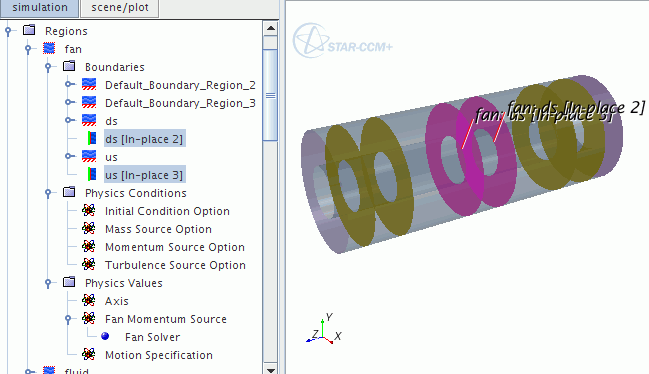Fan Momentum Source Properties
You specify the upstream and downstream boundaries of the fan momentum source, and set the operating rotation rate and the blade angle of the fan.
The example below shows the upstream and downstream boundaries of the fan region. These boundaries must belong to interfaces where the fan region joins the fluid region.

If your simulation uses an operating rotation rate which is different to the rate at which the fan performance curve was measured, Simcenter STAR-CCM+ automatically adjusts the fan curve data to the new rate. For more information, see Scaling the Fan Performance Curve.
You set the fan momentum source properties on the node.
Fan Momentum Source Properties
| Table | Select the fan performance curve table that you imported into your simulation. | |
| Table: VolDot | Select the column that contains the volumetric flow data for the selected fan performance table. | |
| Table: P | Select the column that contains the pressure data for the selected fan performance table. | |
| Operating Rotation Rate |
By default, the fan speed for the simulation is the Data Rotation Rate, the fan rotation rate at which the fan performance curve was measured. If you want to use a different rotation rate in your simulation, specify the appropriate rate here. The available units are radians per second, revolutions per second, and revolutions per minute. Simcenter STAR-CCM+ automatically adjusts the fan curve data to the new rate by using classical fan laws. |
|
| Data Rotation Rate |
Specify the fan rotation rate at which the fan performance curve was measured. The available units are radians per second, revolutions per second, and revolutions per minute. If you want to use a different rotation rate in your simulation, you specify the appropriate rate in the Fan Momentum Source Operating Rotation Rate property. Simcenter STAR-CCM+ automatically adjusts the fan curve data to the new rate by using classical fan laws. |
|
| Data Temperature |
Specify the temperature at which the fan performance curve was measured. The temperature is taken as the mass flow average of the temperature coming into the fan. If you use a different temperature in your simulation, Simcenter STAR-CCM+ automatically adjusts the fan curve data to the new temperature by using classical fan laws. |
|
| Blade Angle | Specify the angle that the fan blade makes with respect to the flow. The available units are degrees, radians, and revolutions. | |
| Coordinate System | Select the appropriate coordinate system. Types other than Laboratory are not available for selection until you create them.
You can use any of the coordinate system types for fan modeling, but the following restrictions apply:
|
|
| Upstream Boundary | Select the boundary that defines the upstream side of the fan.
Select a boundary of the type in-place interface. If none appears in the object selector, create an in-place interface. |
|
| Downstream Boundary | Select the boundary that defines the downstream side of the fan.
Select a boundary of the type in-place interface. If none appears in the object selector, create an in-place interface. |
|